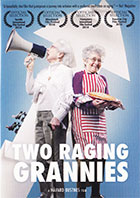
Two Raging Grannies 2013
Distributed by TDC Entertainment, 220 East 23rd St., Suite 405, New York, NY 10010
Produced by Havard Bustnes, Christian Falch, Jasper Jack, Line Halvorsen
Directed by Havard Bustnes
DVD, 78 min., 90 min. bonus material
High School - General Adult
Activism, Economics, Documentaries
Date Entered: 11/13/2015
Reviewed by Susan J. Martin, Acquisitions Librarian, Texas Woman’s UniversityHavard Bustnes’ film Two Raging Grannies markets itself as a documentary exploring the concept of national economic growth as seen through the eyes of two elderly Seattle residents, Hinda Kipnis and Shirley Morrison. From the very beginning this David vs. Goliath film has a forced and dishonest feel about it. Hinda and Shirley are presented as sincere older women searching for answers to their questions on economic growth and whether is it necessary and good for the very first time. Bumbling through phone books and internet lookups, these two naïve truth seekers try to have a conversation with anyone willing to help them understand the complex nature of the economy, GDP, and the growth of business. In fact, Shirley and Hinda are well known activists in the Seattle area, belonging to the activist group “Raging Grannies,” something that the film doesn’t reveal on its own. Googling Shirley Morrison yields articles and interviews with her speaking about her Raging Granny activism and multiple arrests for disorderly conduct.
Lacking even the rudimentary vocabulary to explore a subject where clear distinctions are important, the two ladies somehow manage to hijack each encounter they have. They get kicked out of an economics class at the University of Washington for repeatedly interrupting a professor; a conversation with a local investment banker is extremely short and heavily edited. Somehow they land a lengthy interview in Colorado with physicist Albert Allen Bartlett who is a well-known expert in the field of population growth and human overpopulation. While he is truly both charming and interesting, he is barely able to explain the concept of doubling time between the myriad of Morrison and Kipnis interruptions. Bartlett’s entire interview is included as a bonus feature, and is well worth watching.
Traveling to New York City, the pair meets up with a University of Vermont professor, Joshua Farley who specializes in ecological economics. Unfortunately, he is not allowed to speak much in the presence of the grannies. Bustnes allowed less than three minutes of Farley’s interview to teach us the difference between growth and equity, between size and quality. After this encounter Kipnis and Morrison hatch a plan to infiltrate large companies by pretending to use the ladies’ room and then assault unsuspecting secretaries with probing questions.
The apex (or perhaps nadir) of the film comes when the women magically wrangle tickets to attend the Wall Street Dinner, an annual charity gala for financial A- Listers. We see Shirley Morrison disrupting the proceedings by walking on stage. Interrupting the podium speaker, she loudly asks her question “is economic growth necessary” and attempts to tell the New York financiers how things ought to be. She is escorted off stage by the speakers, but a rude security guard catches her, and (presumably because she made him look bad by getting on stage in the first place) emits the foulest language possible in her ear. It is clear the filmmaker wishes us to empathize with Morrison, and to some extent we do—nobody deserves to have their lives threatened. However, it is also clear by this point in the film that we cannot take the two grannies seriously. They are not looking for answers. They want to show that octogenarians can be activists too.
The film lacks the ability to focus on a single clear question – are we examining economic growth, population growth, climate change? Additionally, Bustnes does not allow for an honest exploration of any of these issues. We are ready to love the grannies – the glimpses into their private lives are touching; we want to relate to them as fellow concerned citizens, and with a better direction they could have won our hearts and minds. We want to see the economy improve in a sustainable way, and would like nothing more than to learn how to make that happen. Between Bartlett and Farley there was exceptional material to work with if Bustnes only chose to use it. He didn’t. We can only hope that the economy will never become the disaster that this film was. This film is not recommended.